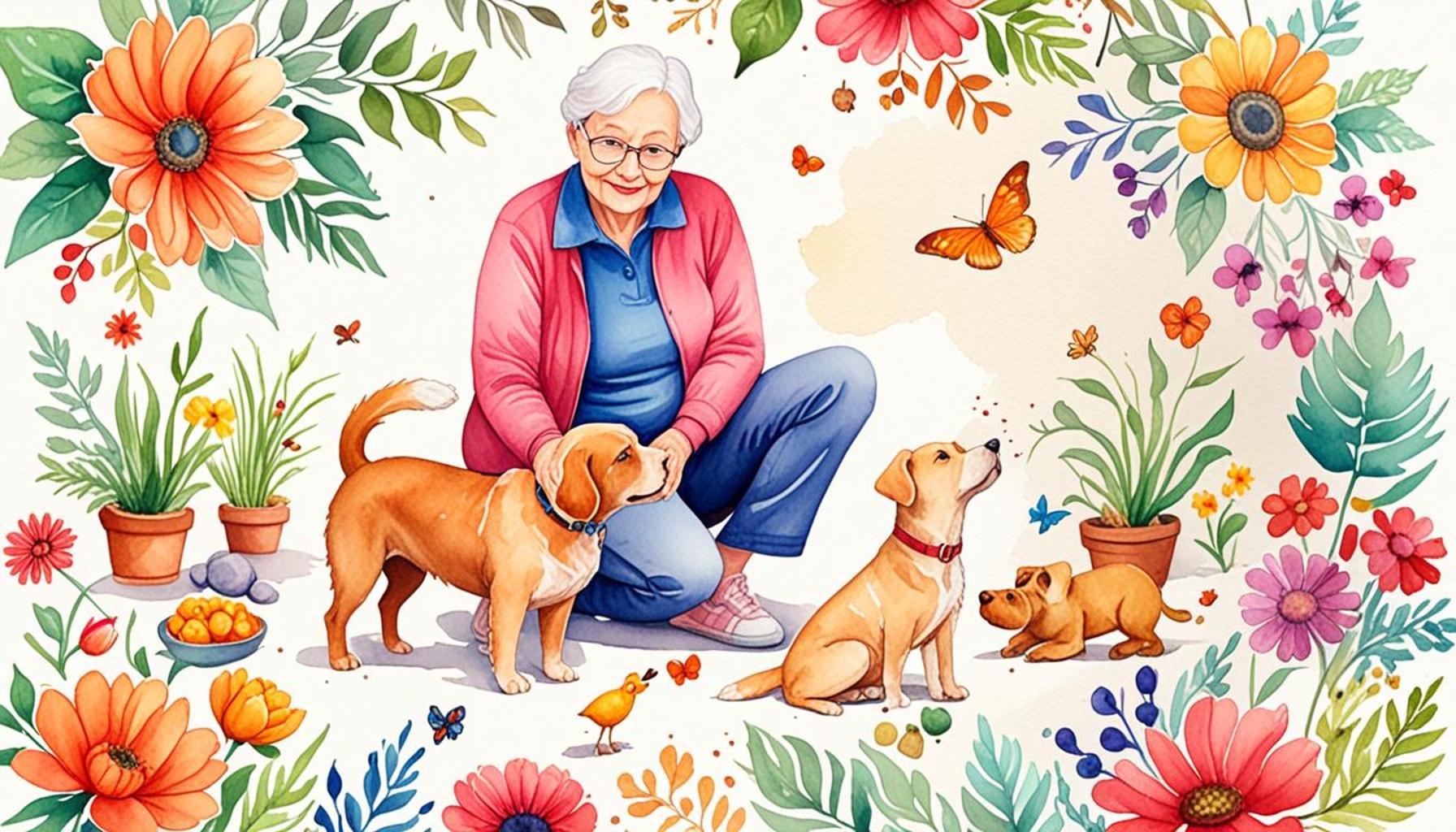Pet Training for Seniors: Adapted Techniques to Improve Coexistence

Enhancing the Bond Between Seniors and Pets
As the population ages, the joy and companionship that pets bring into our lives become increasingly significant. With tailored approaches to pet training for seniors, we can enhance this bond and improve the overall experience for both pets and their owners.
Many seniors may face unique challenges when training their pets, including:
- Limited mobility
- Decreased energy levels
- Potential cognitive changes
Despite these challenges, effective training methods can be adapted to suit their needs. For example, using gentle reinforcement strategies allows seniors to incorporate training in a way that is both rewarding and enjoyable. This approach emphasizes positive reinforcement—such as treats and praise—over punitive measures. Such techniques not only empower seniors but also create a warm atmosphere where pets are motivated to learn while feeling secure and loved.
Equally important is the implementation of short training sessions that fit seamlessly into a senior’s daily routine. Keeping dog training sessions to around 5–10 minutes prevents fatigue and frustration, making it easier for seniors to maintain focus and enthusiasm. This structured yet brief approach ensures that the learning process is enjoyable for both the pet and the owner, fostering a greater level of engagement.
Additionally, cognitive engagement techniques can be extremely beneficial. Activities such as puzzle toys for pets or scent games encourage both mental stimulation for pets and interactive play for seniors, reinforcing their bond. For instance, hiding treats around the home for a pet to find not only engages the pet’s senses but also encourages seniors to get involved physically and mentally, aiding their overall wellbeing.

By understanding these specialized techniques, seniors can improve their relationship with their pets while enhancing their quality of life. Studies have shown that pet ownership can reduce feelings of loneliness and depression in seniors, making it essential to foster this companionship in a way that accommodates their needs. As we explore how adapted pet training can transform everyday interactions into joyful experiences, it’s clear that a harmonious bond between seniors and pets is both achievable and beneficial.
Ultimately, enriching the lives of both seniors and their pets through effective training can lead to a more fulfilling and joyful partnership that withstands the tests of age and circumstance. For those considering pet ownership or looking to improve their existing relationship with an animal companion, tailored training approaches can be a game-changer in nurturing this invaluable connection.
DISCOVER MORE: Click here for effective training tips
Understanding the Unique Needs of Seniors in Pet Training
When it comes to pet training for seniors, it’s crucial to recognize the unique circumstances and capabilities of older adults. The process of training a pet is not merely about commands and obedience; it is also about fostering a meaningful connection. By understanding these needs, pet owners can utilize techniques that align better with the physical and cognitive realities of seniors.
One major consideration is the physical aspect of training. Seniors may have limited mobility, which can affect their ability to participate in traditional training activities. For instance, long walks or activities requiring quick movements might be challenging. To address this, it is beneficial to adapt training sessions to involve less strenuous exercises. Short, focused commands, such as “sit” or “stay,” can be practiced indoors or in an outdoor space close to home. This not only makes training feasible but also instills confidence in the owner while ensuring the pet learns effectively.
Decreased energy levels are another reality for many seniors. Training sessions should be designed to fit within their energy capacity, favoring gentle, incremental learning experiences over intense, extended training marathons. A good strategy is to intertwine training with daily routines; for example, having the pet “wait” at the door before going out can promote discipline with minimal effort. This method allows seniors to maintain a sense of accomplishment without overwhelming themselves.
Moreover, as cognitive changes are a natural part of aging, adapting the approach to training is critical. Consistency in commands, use of simple language, and visual cues can assist in helping seniors communicate effectively with their pets. Studies consistently show that clear communication is key to successful training. Utilizing written reminders or charts for commands can aid memory, ensuring that both the pet and the owner are on the same page during training sessions.
To create a comprehensive training plan that resonates with seniors, consider the following adapted techniques:
- Modeling desirable behaviors: Demonstrating the desired action can provide clear guidance for seniors on how to train their pets.
- Incorporating sensory toys: Stimulating play outside of training can keep pets engaged while also providing mental exercises for seniors.
- Setting realistic goals: Establish achievable milestones to ensure both pets and seniors accomplish tasks together, promoting a sense of joint achievement.
- Utilizing technology: Pet training apps designed with seniors in mind can provide reminders and tips for both owners and pets, enhancing their training experience.
By implementing these techniques, training can be transformed into a rewarding experience that accommodates seniors’ physical and cognitive needs. Beyond obedience, the essence of pet training for seniors lies in fostering a lasting relationship built upon patience, trust, and mutual understanding. As this dynamic evolves, both pets and seniors stand to benefit immensely, enhancing their quality of life together.
| Training Techniques | Benefits for Seniors |
|---|---|
| Positive Reinforcement | Builds trust and confidence, enhancing the bond between pet and owner. |
| Consistency and Routine | Creates a secure environment that can reduce anxiety for both pet and owner. |
| Short Training Sessions | Easy to manage and less physically demanding, increasing engagement. |
| Use of Visual Cues | Enhances understanding, particularly for seniors with hearing limitations. |
In the journey of adapting pet training methods for seniors, techniques like positive reinforcement solidify the relationship between senior pet owners and their beloved animals. This strategy not only boosts the pet’s confidence but also enriches the shared experience, fostering a deeper emotional connection. Moreover, establishing consistency and routine in training can play a pivotal role. As seniors engage in regular, predictable training sessions, both the pets and their owners can enjoy a sense of stability. This predictability is particularly beneficial in alleviating anxiety, creating a harmonious coexistence that enhances overall well-being. Opting for short training sessions offers an accessible approach, allowing seniors to manage these interactions without feeling overwhelmed. Summarily, techniques such as utilizing visual cues can further bridge the communication gap, making the learning process easier, especially for seniors who may face auditory challenges. By exploring these tailored techniques, you can unlock a new realm of understanding and companionship with pets in your golden years.
DIVE DEEPER: Click here to learn more
Creative and Engaging Training Techniques for Seniors
To make the journey of pet training for seniors both effective and enjoyable, innovative techniques can be employed that cater specifically to the physical and cognitive preferences of older adults. By incorporating fun and engaging training methods, seniors can create a conducive environment for learning, enhancing coexistence with their pets in the process.
One of the most effective techniques is through the use of positive reinforcement. Reward-based training not only motivates pets to learn but also cultivates a nurturing bond between pet and owner. For seniors, this could mean using small, low-calorie treats or praise—whatever resonates with their pet. Sticky note systems, for example, can be employed: placing notes on desired training areas with reminders of commands and rewards allows seniors to reinforce positive behaviors visually, ensuring the learning process is both smooth and accessible.
Another beneficial approach is to incorporate short training bursts into daily activities, transforming mundane tasks into training opportunities. For instance, a senior can encourage their dog to “sit” before serving their meals, or “lie down” in wait for a companion to join them on an outing. These small moments harmonize training within daily routines, making it less daunting while enhancing the pet’s understanding of commands.
Moreover, group training sessions with other seniors or community-based pet training clubs can bolster socialization, not just for the pets but also for the owners. Engaging with peers who share similar experiences can relieve the sense of isolation that some seniors might feel. By sharing tips and collectively practicing commands, seniors boost their confidence in training and can create supportive networks while enjoying time with their furry friends.
Technology is another innovative avenue that holds great potential in adapting pet training for seniors. With the prevalence of smartphones and tablets today, various user-friendly applications are designed to aid in pet training. Some apps offer simple step-by-step guides and video demonstrations for commands while enabling reminders for training schedules. For individuals with visual impairments, voice-over capabilities can assist in navigating these resources, ensuring that no senior is left behind due to technological challenges.
Moreover, utilizing interactive games can be a fun training aid. Puzzle toys challenge pets mentally while requiring seniors to facilitate the games, creating interaction and enabling the practice of commands in a playful manner. For example, enriching a dog’s playtime with fetch or hide-and-seek in a safe environment not only strengthens the bond but also cultivates teamwork and cooperation between the pet and the senior owner.
Lastly, involving family members in the training process can significantly influence a senior’s experience. Children or relatives can participate by taking part in training sessions, providing encouragement, and creating a shared experience that emphasizes the importance of cooperation. This collaborative approach integrates support for seniors while creating an enjoyable atmosphere for both pets and humans.
By thinking outside traditional training methods, seniors can embrace a fun, motivational, and adaptive approach to pet training. These innovative techniques enrich both the lives of older adults and their pets, ultimately fostering a deeper and more meaningful coexistence.
DISCOVER: Click here to learn more about positive reinforcement in dog training
Conclusion: Nurturing Connections through Adapted Training Techniques
In conclusion, the journey of pet training for seniors is not merely about teaching commands; it’s about fostering a deep and rewarding relationship between older adults and their pets. By implementing approaches tailored to the unique needs and capabilities of seniors, we can significantly enhance the coexistence shared between them and their furry companions. Through positive reinforcement, short training bursts, and engaging group sessions, seniors can create enjoyable learning experiences that strengthen their bond with their pets.
Moreover, leveraging technology, such as user-friendly apps and interactive games, offers innovative ways to make training not only accessible but also fun. These creative tools can transform training into a social activity, encouraging seniors to connect with their pets and with like-minded peers, combating feelings of isolation that can often accompany aging.
As families support these efforts, sharing training responsibilities can cultivate a cooperative atmosphere that benefits everyone involved. The commitment to thoughtful training nurtures not only a well-behaved pet but also enriched lives for seniors, promoting both mental and emotional well-being.
Ultimately, by embracing adaptive techniques in pet training, we pave the way for more harmonious living environments. As society increasingly recognizes the profound impact of animals on human lives, it becomes crucial to equip seniors with the tools they need to thrive alongside their pets. As we move forward, let us continue to explore and expand these adaptable methods, fostering a compassionate community for pet owners of all ages.


